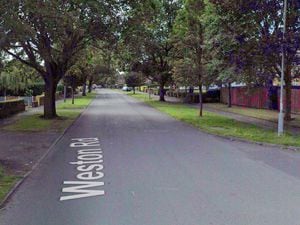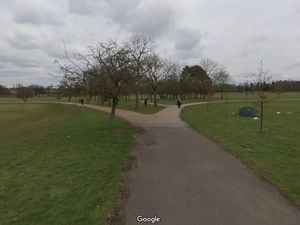REVEALED: Which crimes are on the up in your neighbourhood?
The Express & Star today explores the latest figures in-depth to help you discover the crime rates in your area.
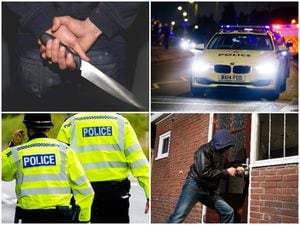
A sharp rise in crime has come amid growing concerns over policing and a fall in officer numbers.
Today the Express & Star reveals which crimes are on the rise in your area, community reaction and the response from police and law makers.
Spikes in violence, sex offences and robberies have been revealed in the figures.
The picture in the Black Country
Violent crime across the Black Country has almost doubled in five years, while weapons possession has also rocketed, a study of new crime figures has revealed.
The statistics from the Office of National Statistics show a trend across all four boroughs – Wolverhampton, Dudley, Sandwell and Walsall.
Weapons possession, vehicle offences and sex attacks have all increased.
But the number of drug offences has fallen.
Shoplifting, bike thefts and criminal damage and arson vary from borough to borough.
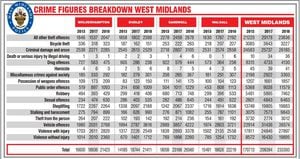
In Wolverhampton, the number of people caught with guns, knives and other weapons has rocketed by 91 per cent in the five-year period, with the figure going up by 20 per cent in the last 12 months alone.
There were 209 weapons possession offences in the year to March 2018, up from 173 at the same time last year. In 2013 the figure was 109.
And violent crime resulting in injury has also surged – with 2,360 offences recorded in the 12 months to March – up 132 per cent over five years.
Violent crime that does not result in injury – which includes online threats – has also risen sharply, up 132 per cent over five years from 1,014 to 2,360.
And there has been a spike in the number of robberies.
In Dudley, violent crime involving injury has almost doubled in the five years.
Police recorded 2,549 such incidents in the borough over the year up to March this year.
This is up 20 per cent from the year before and a 99 per cent from five years ago. Violence without injury also rocketed, from 670 to 1,712 in five years.
Worryingly, like Wolverhampton, the number of weapons possession offences almost doubled over the five years.
Drug offences, however, have slumped.
Overall, crime increased in the borough 50 per cent over the five years, to 21,411 recorded incidents over the latest period.
In Sandwell, it was much the same story again.
Violent crime with injury doubled over five years from 1,838 to 3,378, as did violent crime without injury, rising from 769 to 2,260.
Robberies, weapons possession and the total number of offences also went up, while drug offences dropped.
The total number of recorded offences rose to 26,560 offences, up from 18,059 five years ago.
In Walsall, incidents of violence with injury went up to 2,558 – a rise of 70 per cent over five years, along with violence without injury, also up 70 per cent to 1,732.
The borough saw rises in robberies, sex attacks vehicle offences, and also public order offences which include antisocial behaviour. Drug offences were down again.
Dudley Council deputy leader David Vickers, who is also a former police officer, said: “Drug offences are not so reactive as crimes such as attacks and burglaries, so it is not a surprise, with fewer officers, there is a drop in drug offences.”
Wolverhampton Business Crime Reduction Group was set up two years ago to combat rising levels of crimes that were impacting business.
Chairman Kanti Patel said the group had reduced crimes such as burglaries and littering by bringing firms together.
This has happened in Mount Pleasant in Bilston, he said.
He added: “Crime is rising across the board so groups such as ours are trying to do as much as we can.
“We realise resources aren’t what they were, which is why we must step up.
"The increase is caused by problems such as unemployment in the area. With the support of police, businesses and the community we are taking on crime.”
What will be done to tackle the rise in crime?
West Midlands Police and Crime Commissioner, David Jamieson, said: “Crime has been consistently rising for some time, further emphasising why the government need to put more resources into policing.
“The rise in crime in the West Midlands is in line with the rest of the country.”
He added: “We have lost over £145 million since 2010, meaning we now have over 2,000 fewer officers.”
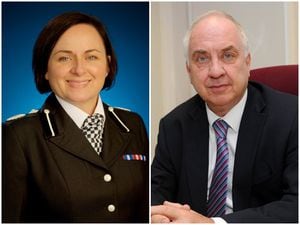
West Midlands Police Deputy Chief Constable Louisa Rolfe said the force was prioritising violent crime and working with partners to address the root causes of the increase.
She said: “The figures show that the West Midlands is experiencing similar to that seen elsewhere in the country.
“As a force, we continue to focus on the crimes that do most harm to the communities, in the face of unprecedented demand upon policing.
"We understand people’s concerns about violent crime and the effect it can have on communities.
"While it makes up a very small proportion of overall crime, we appreciate the disproportionate impact it has on people’s quality of life and feelings of safety.
"Our investments in technology enable us to keep more officers on the streets, where the public need them.
“We continue to revolutionise the way that we work, equipping officers with the tools that they need to do the job, such as apps allowing them to access intelligence on the ground, and body worn video.
“Our investments in technology enable us to keep more officers on the streets, where the public need them. More broadly, we are working with partners to understand what’s behind the rise in crime and address the root causes.
“In the West Midlands we have invested in local policing to work with communities and effectively address what concerns them the most.
“We’re prioritising violent crime; encouraging schools and other agencies to invest in education to prevent young people from getting involved in violent crime.
“We’re leading work to reduce repeat offending, while actively targeting offenders involved in the organised crime which is behind recent increases in vehicle crime and burglary.”
What are the crime rates across Staffordshire?
Anti-social behaviour continues to strangle the boroughs of Staffordshire, a study of the county’s crime figures has shown.
The county also mirrors the national picture, and West Midlands, with rises in weapons offensives, robberies and violence.
But, interestingly, the typically rural counties have suffered a huge rise in public order offences.
These include people drunk, acting disorderly and lighting fires in open air.
The figures were released by the Office of National Statistics (ONS) yesterday.
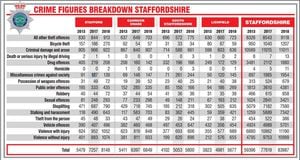
In South Staffordshire, the public order offences more than doubled over five years up to 166 offences last year.
While in Stafford they increased more than 100 per cent to 435, as they did in Cannock Chase, from 152 to 335.
Lichfield residents also suffered a rise in the offences, up to 269. Across Staffordshire, there were also big increases in stalking and harassment and violent crime.
Essington Parish Council chairman Peter Lever said he was to meet with police over visibility in South Staffordshire.
A report, which was published earlier this year, showed that police time on the beat in the area had dropped 12 per cent in one year.
The force said the neighbourhood team had since been bolstered.
But Councillor Lever said: “We don’t feel like we’re seeing an improvement in police visibility yet.
“And obviously when you hear of an increase in crime you want to see a response.
“At the moment we have issues of shed break-ins and there are reports of drug exchanges.”
Stafford borough councillor Christine Baron, secretary of the crime prevention panel, was herself a victim of a robbery while shopping last week. She was distracted as she shopped for cards and her purse was taken from her bag, with £50 inside.
She said: “The latest crime figures are disappointing, but we are following a national trend. I feel we need more discipline in society. This can’t keep going on.”
How will the crime rise be tackled in Staffordshire?
Staffordshire Police today responded to the figures, providing updated statistics up to June this year, which the force says shows a five per cent increase in the last year.
The force also emphasised violence against a person did not always include physical harm. It can include incidents of online abuse.
However, it did acknowledge a big rise in vehicle thefts in the south of the county, with incidents up by 42 per cent.
Officials tweeted: "We understand the concerns around any rise in crime and the impact it can have on the quality of life of those who live, work and visit Staffordshire.
"We will continue to prioritise the crimes that cause the greatest harm, as well as tackling the issues that cause local concern."
The force is undergoing a restructure with more investment going to neighbourhood policing.
More than 70 will be recruited by the end of this month under the plan, which was announced in May.
Deputy Chief Constable Nick Baker said: “We understand people’s concerns around any rise in crime and the impact it can have on the quality of life of those who live, work and visit Staffordshire and we will continue to prioritise the crimes that cause the greatest harm, as well as tackling the issues that cause local concern.
“Over the past 12 months we have introduced a more modernised service to policing in Staffordshire, which has seen a significant investment in neighbourhood policing.
“These officers are focusing more on proactive policing in communities, developing specialist capabilities for more complex crime and working with our partners to find effective ways of intervening early to prevent crime and harm.”
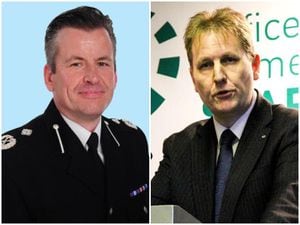
Staffordshire Police and Crime Commissioner Matthew Ellis said: “There are unquestionably societal changes going on which are challenging for the police and for society.
“The use of social media to bully or abuse is growing as is borne out by figures around violent crime, which online abuse is designated as.
“The increases in neighbourhood policing numbers resulting from people across Staffordshire paying a little more local tax will make a real difference as well as improving the capacity of Staffordshire Police.
“As well as new investment, the redesign of policing by Staffordshire’s new Chief Constable means visible policing will continue to increase.”
Mr Ellis added: “Our figures show that, in Staffordshire, the crime increase is half the national average.”
In the West Midlands the figures, published by the Office for National Statistics, showed there were 233,393 crimes in 2017/18 compared to 170,713 in 2013/14 – an increase of more than 1,000 every week. Bosses pointed to a lack of resources.
Car crime will be a force focus
Staffordshire Police said there had been a ‘sharp increase’ in the number of cars stolen in the south of the county.
Our study showed vehicle offences rose in all boroughs, nowhere higher, however, than in South Staffordshire, where there were 647 reported last year.
A spokesman for the force said: “Technological advances are changing the way car criminals access and steal vehicles so we continue to work with the car industry to make it harder for criminals to commit these offences.
“Car owners are also being issued with security advice and extra patrols of officers are working to tackle the issue in the areas affected.”
In May, the force announced there would be 75 new neighbourhood police officers recruited across the county by the end of this month.
They include seven in Stafford, eight in South Staffordshire, seven in Cannock Chase, and six in Lichfield.
Fifty detectives will also be added to the force by the autumn.
National reaction and Government response
Che Donald, vice chairman of the Police Federation of England and Wales, said: "These new figures are proof, as if we even needed it, that policing in the UK is on the critical list."
Police minister Nick Hurd said: "The independent Office for National Statistics is clear that the likelihood of being a victim remains low, however, every violent crime is a significant concern and the Government is taking decisive action to tackle it.
"We recognise that crime is changing and that police demand is becoming increasingly complex.
"The statistics show that there has been a societal shift towards victims reporting 'hidden' crimes to the police and we welcome that more victims of domestic abuse and sexual violence are feeling empowered to come forward."
National Police Chiefs' Council Lead for Crime Statistics, Chief Constable Bill Skelly, said: "There are a range of factors affecting detection rates.
"Firstly police forces are improving the way they record crime, including crimes that have no suspect and little prospect of a criminal justice outcome.
"There are also significant rises in cases that are complex to investigate such as child sexual exploitation, abuse and online fraud.
"In many of these cases, multiple crimes are recorded which victims may not wish to take through to prosecution.
"Increased demand and fewer officer numbers have also had an impact. Police can use alternatives to prosecution like cautions or restorative justice."

